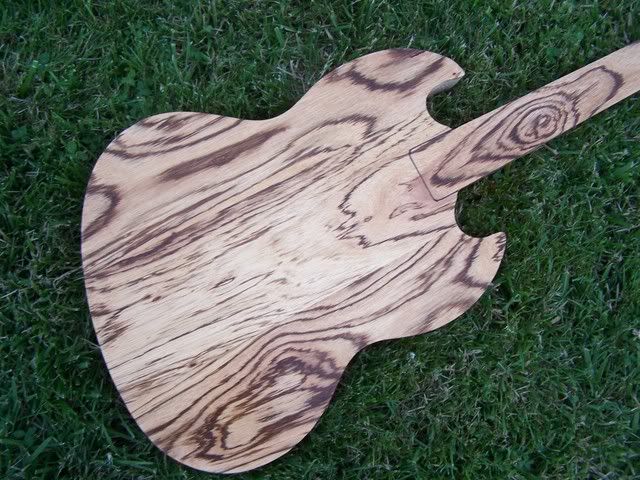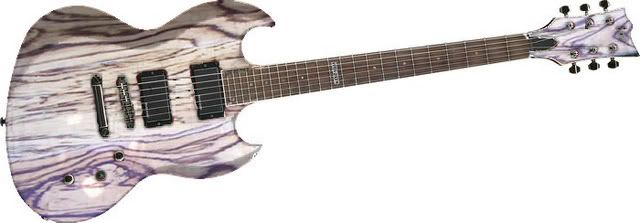-
Posts
686 -
Joined
-
Last visited
-
Days Won
2
Content Type
Profiles
News and Information
Tutorials
Product Reviews
Supplier Listings
Articles
Guitar Of The Month
Links and Resources
Forums
Gallery
Downloads
Posts posted by zyonsdream
-
-
it's a bit thin for me but for an Ibanez style it should work
-
scale length on the padauk fretboard? I might be interested in it if it's 25.5"
Looks like he said it was 34" scale.

Yah, I read the post twice and overlooked it both time! Please excuse my stupidity!
-
scale length on the padauk fretboard? I might be interested in it if it's 25.5"
-
Most Mexican style luthiers will tell you to use a hand plane and do the by hand. However, with a low cost jointer and a precision square you can get perfect joints.
I run my boards through the planer to get my top and back parallel and then I use the face of the board against my fence and square up my edges with the jointer. I do this with the neck blank and both wing boards.
For standard bodies a 6” jointer should be fine. I purchased mine from Harbor Freight and it’s a floor model. With a little fine tuning you should be able to achieve a high level of success with a lower cost jointer.
-
Looks real nice. Personally, I would have just built the neck myself though. Seems like a waste to destroy an SG just to keep the neck.
agreed %
-
Yup, most of my stap pins are on the back of the guitar which prevents weakening the tip of the wing. You can usually get away with a side mounted step pin on the butt but the upper strap pin usually looks best behind.
-
I really love musicians who can make an instrument tell a story or show sorrow just with it's tone.
Jimi Hendrix
Kurt Cobain
Dave Matthews
Max Cavalera
Izzy- let's be honest, he's the only reason Slash ever sounded good!
-
a 1mg pot...would be interesting to hear!
-
Could be a house brand guitar. I once had a Memphis guitar which was a house brand for CA House Music out of St.Clairsville OH. If that's the case you'll likely find very little help on locating it's origins as house brand guitars are pretty much extinct .
-
The B5 has a smaller base than the one Fender uses on thier facory guitars. The Fender that I worked on had obvious tuning issues with the floating bridge and a lower than high quality bigsby clone. If I were going to do this to a guitar on my own I'd use roller saddles on a standard tele bridge and a B5 Bigsby bridge. I'd also throw on a graphite nut or even an LSR roller. The bigsby is great but if you are always going out of tune then is it really worth it.
I have a first generation Les Trem that I did all of this with and it really stays in tune nicely.
-
just keep in mind, any slight bump or dip will show x-fold on a routed body edge. It's easier to clean up a template than it is a complete body. I don't just a template routing bit anymore due to tear out. I come very close to the final size and then sand the edges to where I'm happy.
-
-
Well I finished up some work and was able to get time to work on this build. I have to split my time between this one and a custom Telecaster I'm building but work should go pretty quick... famous last words I guess.
I got the body and neck profile cut out.. tomorrow I'll plane the neck to get the angle correct, route the truss rod cavity and angle the headstock. If I have time I'll cut the headstock profile.
I have to say that cutting the profile was a PITA. I ended up using a router...cut like hell, a micro planer...worked better in spots and then I went to the drum sander. Cutting this stuff with a router is simply a joke. I've built a lot with quarter sawn zebra and it cuts like butter compared to flat sawn zebra.

Not much off from the mock up that was done

-
You can oil purpleheart and it will stand up very well. PH is super dense and very very hard. The color change would bother me becuase it turns an odd shade of brown.
This guitar has a purple heart fretboard (and body) which was clear coated with a UV blocker. To this day it's the same reddish purple it was the day it was buffed out.

-
I used a piece of flamed burch on a Tele neck I did a while back. Used a cocobolo fretboard and so far, I've not recieved any reports of it being unstable

I have a top around the shop with the same flame... just haven't found a reason to use it yet. I like burch becuase it has those brown specks in it that maple doesn't have. I also have some ambrosia burch too...
-
There is just something about seeing those 70's players with their 30 foot cables that makes me cringe at the fact of using wireless. Can you imagine Angus Young not getting all tangled up in his cord as he is spinning around on stage on his side???
-
The biggest thing about this job for me was the fact that this was the first time I used a little 59' from Seymour Duncan and wow, was I ever impressed. With the bridge and tail on this tele it seiously lacked in the tone and sustain department and that pickup really brought it to life. This is the first Fender I would actually want to own.
-
I use them too and they can be very aggressive. I have a very large production style drill press so I don't see very much flex when pushing but really, as aggressive as these things are, you should not have to push hard. It is possible to flex the metal sleeve as it's very thin. It works great on end grain and I also have to agree with the assessment that it's best not to go to your finished size. The end guide is far from precise.
If you don't hold your work steady it can also grab it and pull it into the blade too....
I was actually using one last night to help with the zebrawood build I've started and they make light work of tough wood but again, I'd bring it close and then use your router for the rest.
-
I've always loved what you do with your relic'd guitars because you don't go overboard with them WezV. The encouraging words mean a lot!
-
I really like the inlay on the fretboard...nice
-
alot of times when I get to the points I actually do them by hand. I rough most of it down and then file and sane the last inch or so by hand. Keeps from chipping the tips off.
-
I did rub some dirt into it which really did not shine through on the pictures. I modeled this after my 1976 Guild S100 which has seen a lot of road time in it's day. The tele that was pictured above this post is drastic and to be honest I've never actually seen an authentic (with an owner who cared for his instrument) that looked like that.
My Guild was used a lot but was cared for.
I would have liked the ash to take a bit more of the dirt on the face of the guitar but I didn't want to leave the wood too rough. Most of the chips and dents in the body wood have had a healthy dose of dirt.
BTW, I gave it back to the owner today who was floored with it. Like I posted earlier, they wanted some age and road abuse and compared to my naturally worn Guild it measures up. I have a lot of respect for the work that goes into an extreme relic but in most cases, you never see a well taken care of instrument in that condition.
-
Yeah, the big problem with those 50s reissues is that they're coated in polyester armor. There's no way to get that stuff looking like a real old guitar. Your buddy should let you go all the way and strip the body down and refinish it in nitro. Then the guitar will age naturally.
I can say that the 50s reissue Esquire I have here is one of the nicest teles I've ever heard, awesome beefy twang. Ash body, stock pickup. Great neck too, love the radius. Fit and finish were pretty good, and a quick setup was pretty much all it took to turn into one of my favorite guitars ever. Except for the finish, which I'd love to strip off and refinish (but the guitar's not mine, so I'm not allowed).
Actually it is nitro
-
The picture doesn't show much of the wear on the pickgurd and chrome. The owner didn't want me to get too aggressive with the neck. He wanted used, not abused and he wanted to do some aging naturally. Scoring the chrome will help accelerate the pitting process. The camera finish made some of he chrome look shiny but it looks much more beat up in real life than it does in the pictures.
I suggested the freezer idea but spider cracks didn't suit their wants. I looked at several well played and well maintained guitars from the 50's and not all of them look like they were drug through WW2. The only thing I would have liked to see was more wear n the fretboard but I was specifically asked to take the shine off the hardcoat and leave it at that. I did go as far as to dull the frets and ding up the headstock a bit.



I'm Hesitant To Start This Thread, But...
in In Progress and Finished Work
Posted
Have fun with the purple heart! Tough as hell. Seems like an ambitious build for a first go-around!